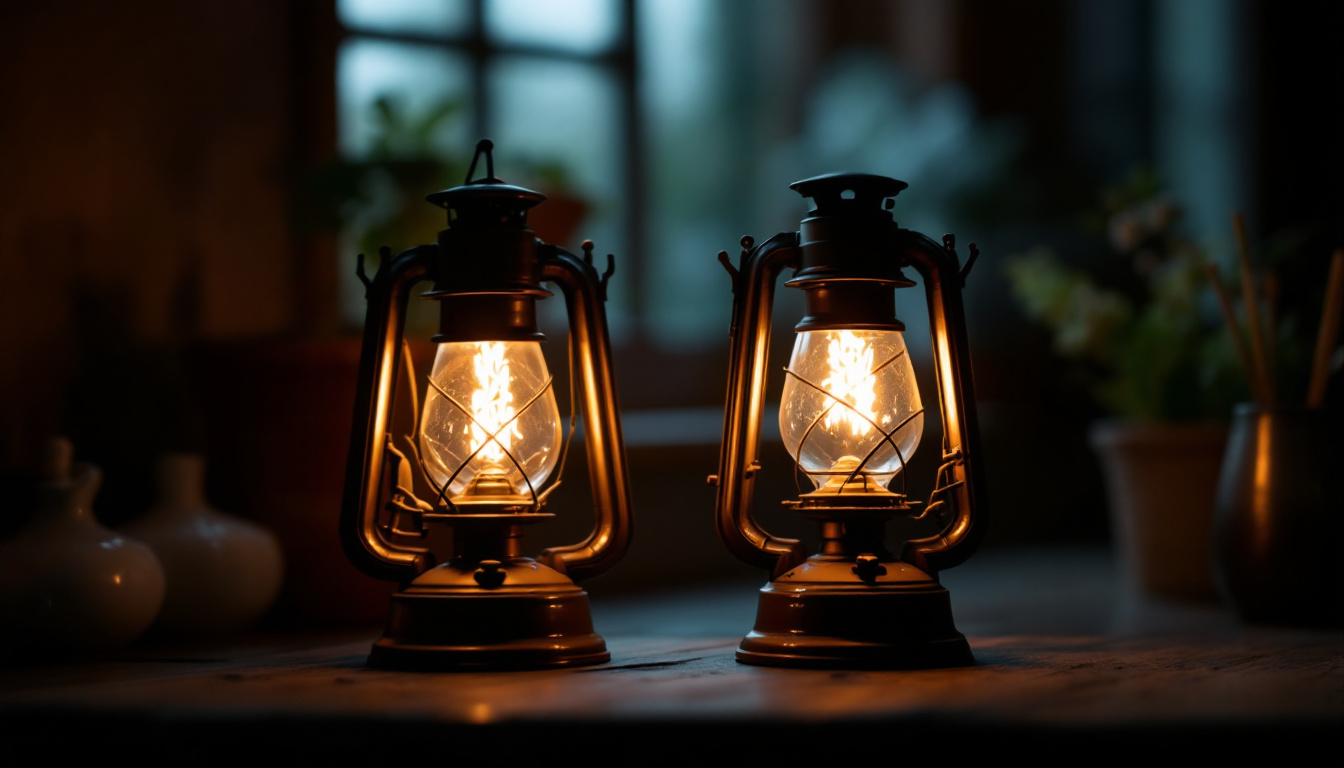
The world of lighting has undergone significant transformations over the years, with various technologies emerging to illuminate homes and businesses. Among the most common misconceptions in the lighting industry is the belief that Thomas Edison was responsible for the invention of gas or oil lamps. This article aims to clarify this misconception while also addressing common mistakes made by lighting contractors. Understanding the history and technology of lighting can help contractors avoid pitfalls and enhance their service offerings.
Gas and oil lamps have a rich history that predates Edison’s contributions to electric lighting. Gas lamps, which utilize gas as a fuel source, were developed in the late 18th century. These lamps were primarily fueled by coal gas, a byproduct of coal combustion, and were widely used in urban areas for street lighting and indoor illumination. The introduction of gas lighting significantly transformed cities, allowing for safer and more vibrant nightlife, as streets became illuminated and public spaces more accessible after dark. This innovation not only enhanced security but also encouraged social activities, leading to the establishment of theaters, restaurants, and other venues that thrived in the glow of gas lamps.
On the other hand, oil lamps have been in use for thousands of years, with evidence of their existence dating back to ancient civilizations. These lamps typically used animal fats or vegetable oils as fuel. The simplicity and effectiveness of oil lamps made them a popular choice for lighting long before gas lamps became mainstream. In fact, archaeological findings have uncovered oil lamps in ancient Egypt, Greece, and Rome, showcasing their integral role in daily life and religious ceremonies. The design of oil lamps evolved over the centuries, with artisans crafting intricate designs that not only served functional purposes but also reflected the artistic sensibilities of their time.
While Edison is often mistakenly credited with the invention of gas and oil lamps, his true legacy lies in the development of the practical incandescent light bulb. Edison’s innovations in electric lighting revolutionized the way people illuminated their spaces, leading to the widespread adoption of electric lighting systems. His work on the electric light bulb involved not just the creation of the bulb itself but also the development of a complete electrical system, including generators and wiring. This comprehensive approach to electric lighting is what set Edison apart from his predecessors and contemporaries in the field. Edison’s vision extended beyond mere illumination; he aimed to create a reliable and safe electrical infrastructure that would enable entire cities to be powered by electricity, fundamentally changing the landscape of urban living.
Moreover, Edison’s relentless pursuit of innovation led to significant advancements in materials and technology. For instance, he experimented with various filament materials before settling on carbonized bamboo, which proved to be the most effective for long-lasting light. His establishment of the first electric utility company also paved the way for the electrification of homes and businesses, making electric lighting accessible to the general public. This monumental shift not only illuminated spaces but also catalyzed the development of numerous industries reliant on electricity, further embedding Edison’s contributions into the fabric of modern society.
Despite the clear distinctions between gas, oil, and electric lighting, many lighting contractors still harbor misconceptions about these technologies. One of the most prevalent mistakes is assuming that Edison’s work encompassed all forms of lighting. This misunderstanding can lead to confusion when discussing historical context with clients or when making recommendations for lighting solutions. It is crucial for contractors to have a well-rounded understanding of the evolution of lighting technologies, as this knowledge can enhance their credibility and improve client relationships.
Another common error is the failure to recognize the ongoing relevance of gas and oil lamps in certain applications. While electric lighting is now the standard, gas lamps are still used in specific contexts, such as outdoor lighting in historic districts or for aesthetic purposes in certain architectural designs. Additionally, there is a growing trend towards using oil lamps in eco-friendly and off-grid living scenarios, where traditional electricity sources may not be available. Understanding these nuances allows lighting contractors to provide tailored solutions that respect the historical significance and practical applications of all lighting types, ensuring that each project is approached with the appropriate level of expertise and appreciation for the technology involved.
Lighting contractors often face challenges in the design and installation process that can lead to subpar results. Understanding these common pitfalls can help contractors deliver better outcomes for their clients.
One of the most significant mistakes a lighting contractor can make is failing to plan adequately for a project. This oversight can result in poorly lit spaces, inefficient energy use, and dissatisfied clients. A thorough design process should consider factors such as the purpose of the space, the desired ambiance, and the specific lighting needs of the occupants.
Additionally, contractors should take into account the layout of the space, including the placement of furniture and architectural features. A well-thought-out lighting design enhances the functionality and aesthetics of a space, while a haphazard approach can detract from the overall experience. For instance, in a restaurant setting, the lighting should create an inviting atmosphere that encourages patrons to linger, while in a workspace, it should promote productivity and reduce eye strain. By tailoring the design to the unique characteristics of each environment, contractors can significantly elevate the quality of their work.
In today’s environmentally conscious world, energy efficiency is more important than ever. Contractors must be aware of the energy consumption associated with different lighting options and strive to recommend solutions that minimize energy use. This includes understanding the differences between incandescent, LED, and fluorescent lighting.
Choosing energy-efficient options not only benefits the environment but also saves clients money on their energy bills. By neglecting this aspect, contractors risk damaging their reputation and losing potential business opportunities. Moreover, many clients are now looking for sustainable solutions that align with their values, and by offering energy-efficient lighting, contractors can position themselves as forward-thinking professionals. Incorporating smart lighting systems that allow for automated control and scheduling can further enhance energy savings, making it a win-win for both the contractor and the client.
Another common mistake is failing to consider the maintenance and longevity of lighting fixtures. Some contractors may prioritize aesthetics over practicality, leading to the installation of fixtures that are difficult to maintain or replace. This oversight can result in increased costs for clients in the long run and may lead to dissatisfaction with the lighting solution.
Contractors should educate their clients about the maintenance requirements of different lighting options and recommend fixtures that balance style and practicality. This approach not only enhances client satisfaction but also establishes the contractor as a knowledgeable and reliable professional. Furthermore, providing clients with a maintenance schedule or service options can foster long-term relationships and encourage repeat business. By addressing these concerns upfront, contractors can ensure that their lighting installations remain functional and visually appealing for years to come, ultimately enhancing their reputation in the industry.
To avoid the common mistakes outlined above, lighting contractors should adopt best practices that ensure successful project outcomes. Implementing these strategies can lead to improved client relationships and a stronger reputation in the industry.
Before embarking on any lighting project, contractors should conduct a comprehensive assessment of the space. This assessment should include an evaluation of the existing lighting, the needs of the occupants, and any specific challenges posed by the environment. By gathering this information, contractors can develop tailored lighting solutions that meet the unique requirements of each project.
Involving clients in this assessment process can also foster collaboration and ensure that their preferences and needs are taken into account. This collaborative approach can lead to more successful outcomes and increased client satisfaction.
The lighting industry is constantly evolving, with new technologies and trends emerging regularly. Contractors should make it a priority to stay informed about the latest developments in lighting design, energy efficiency, and smart lighting solutions. This knowledge enables contractors to offer clients the most up-to-date recommendations and ensures that they remain competitive in the market.
Attending industry conferences, participating in workshops, and subscribing to relevant publications can help contractors stay current with these trends. Networking with other professionals in the field can also provide valuable insights and foster collaboration.
Exceptional customer service is a cornerstone of success for lighting contractors. Building strong relationships with clients can lead to repeat business and referrals, which are crucial for long-term success. Contractors should prioritize clear communication, responsiveness, and professionalism throughout the project lifecycle.
Taking the time to address client concerns and providing ongoing support after the installation can significantly enhance the overall experience. By demonstrating a commitment to customer satisfaction, contractors can differentiate themselves from competitors and establish a loyal client base.
In conclusion, the misconception that Thomas Edison invented gas or oil lamps highlights the importance of understanding the historical context of lighting technologies. While Edison’s contributions to electric lighting were groundbreaking, gas and oil lamps have their own rich histories that continue to influence the industry today.
By recognizing and addressing common mistakes, lighting contractors can improve their practices and deliver better results for their clients. Implementing thorough assessments, staying informed about industry trends, and providing exceptional customer service are essential strategies for success in the competitive lighting market.
Ultimately, a well-informed and proactive approach will not only enhance the quality of lighting installations but also elevate the reputation of lighting contractors as trusted professionals in their field.
As you strive to avoid common mistakes and elevate your lighting projects, LumenWholesale is here to support you every step of the way. Our commitment to providing contractors with top-quality, spec-grade lighting products at unbeatable wholesale prices ensures that you can light up any space with confidence. With our extensive selection that meets the highest industry standards, you’ll find the perfect lighting solutions for your clients, all while enjoying the benefits of bulk buying without the hassle. Say goodbye to inflated markups and hidden fees, and hello to reliable, high-performance lighting. Ready to enhance your lighting installations with the best value in the market? Discover the LumenWholesale difference and make your next project shine by visiting our selection at Wholesale Lighting at the Best Value.

Discover everything lighting contractors need to know about LED flat panels in this comprehensive guide.

Discover how 100,000-lumen technology is revolutionizing the lighting industry, offering contractors unprecedented brightness and efficiency.

Discover innovative cost-saving strategies for lighting contractors with LED ballast solutions.

Discover the often-overlooked aspects of ceiling tube lights that lighting contractors miss.